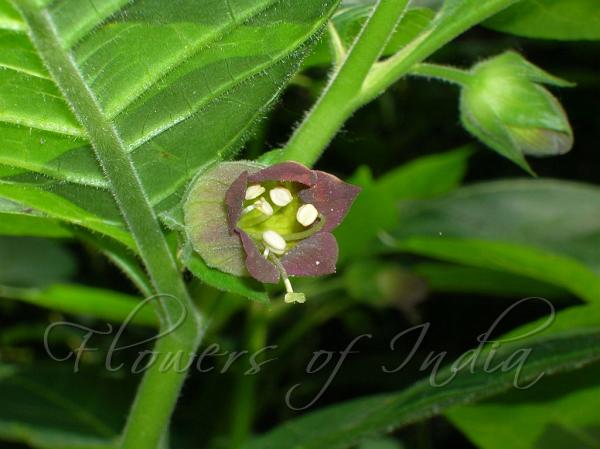|
| Belladonna |
|

|

| File size | 123186 |
| Original date | 6/19/05 12:57 PM |
| Resolution | 1024 x 768 |
| Flash | Flash fired, auto |
| Focal length | 17.1mm |
| Exposure time | 1/60s |
| Aperture | 8.2 |
| Focus Distance | |
| Metering Mode | Multi-segment |
| Camera make | NIKON |
| Camera model | E5600 |
| Sensor type |
|
|
|
|
Photo: |
Botanical name: Atropa bella-donna Family: Solanaceae (Potato family)
Synonyms: Atropa belladonna
Synonyms: Atropa belladonna
Belladonna is a perennial branching herb growing to 5 feet tall. The
leaves are dull, darkish green in colour and of unequal size, 3-10 inches
long, the lower leaves solitary, the upper ones in pairs alternately from
opposite sides of the stem, one leaf of each pair much larger than the
other, oval in shape, acute at the apex, entire and attenuated into short
petioles. First-year plants grow only about 1 1/2 feet in height. Their
leaves are often larger than in full-grown plants and grow on the stem
immediately above the ground. Older plants attain a height of 3-5 ft,
occasionally even 6 ft. The flowers, borne in leaf axils, are of a dark
and dingy purplish colour, tinged with green, about 2.5 cm long, pendent,
bell-shaped, furrowed. The flowers have five large teeth or lobes,
slightly reflexed. The fruit is 0.5 inch smooth berry, which ripens to
acquire a shining black or purple color. Every part of the plant is
extremely poisonous, and can result in poisoning of not handled carefully.
Medicinal uses: The plant is believed to be narcotic, diuretic,
sedative, antispasmodic, mydriatic. Belladonna is a most valuable plant in
the treatment of eye diseases, Atropine, obtained during extraction, being
its most important constituent on account of its power of dilating the
pupil.
The plant is believed to be narcotic, diuretic,
sedative, antispasmodic, mydriatic. Belladonna is a most valuable plant in
the treatment of eye diseases, Atropine, obtained during extraction, being
its most important constituent on account of its power of dilating the
pupil.
Medicinal uses:
 The plant is believed to be narcotic, diuretic,
sedative, antispasmodic, mydriatic. Belladonna is a most valuable plant in
the treatment of eye diseases, Atropine, obtained during extraction, being
its most important constituent on account of its power of dilating the
pupil.
The plant is believed to be narcotic, diuretic,
sedative, antispasmodic, mydriatic. Belladonna is a most valuable plant in
the treatment of eye diseases, Atropine, obtained during extraction, being
its most important constituent on account of its power of dilating the
pupil. | Identification credit: Ramesh Raju | Photographed in Andhra Pradesh. |
• Is this flower misidentified? If yes,